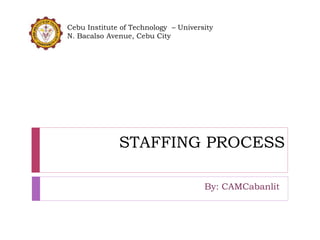The document describes the staffing process, which includes 8 steps: 1) human resource planning, 2) recruitment, 3) selection, 4) induction and orientation, 5) training and development, 6) performance appraisal, 7) employment decisions, and 8) separations. It provides details on each step, such as the different sources for recruitment, methods for selection like testing and interviews, and types of training programs. The overall staffing process involves analyzing workforce needs, acquiring qualified candidates, and developing employees to fill positions within an organization.




















